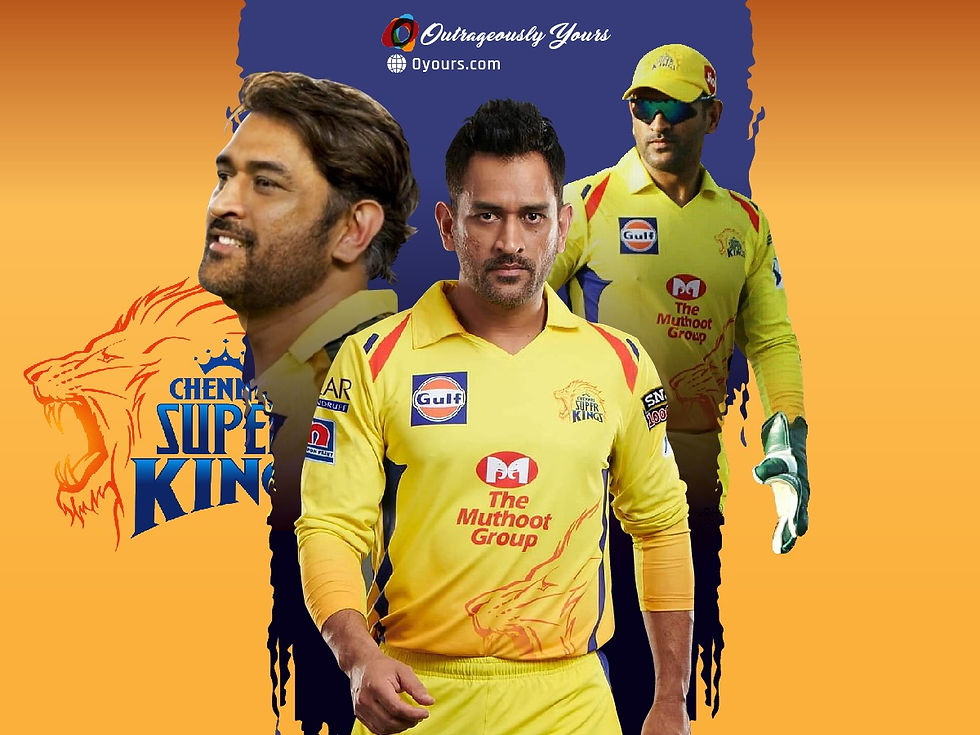TEENS REDEFINE POWER IN IPL
- Outrageously Yours

- Apr 29
- 4 min read
They aren’t waiting for a chance. They’re taking over. IPL’s new teenage strike force is rewriting the rules of power — and making the veterans look outdated.

Vaibhav Suryavanshi the rising star
A fearless new generation is ripping through the old order in the IPL. Across hundreds of academies, teenagers are no longer groomed for five-day cricket — they are factory-finished to dominate T20.Sharper Focus. Faster Reflexes. Greater Ambition.
This isn't evolution — it’s revolution. In a tournament where specialists matter more than survivors, and where return on investment trumps patience, the rise of teenage cricketers like Vaibhav Suryavanshi is inevitable.
This is not just about talent. It’s about the timing when to swing the bat, hunger, and ruthlessness. The IPL’s future hasn’t just arrived — it has exploded onto the scene, younger, sharper, and hungrier than ever.
YOUNGER, SHARPER, MORE BUSINESS-FRIENDLY
Today, hundreds of cricket academies across India are not just teaching the game; they are manufacturing IPL-ready specialists. These are the boys who start dreaming of T20 contracts long before they can spell "Test cricket." Their focus is sharper. Their reflexes, fine-tuned to the microsecond demands of modern T20s, often outmatch those of seasoned veterans.
They may not have the worldly maturity that a 28-year-old Ranji star carries, but they more than compensate with raw athleticism, faster reaction times, and an almost robotic dedication to drills and data.
In a format where one ball, one catch, or one boundary can turn millions into billions for franchises, these sharper reflexes are gold.
THE RISE OF THE FACTORY-FINISHED CRICKETER
Today, across hundreds of cricket academies, from Ranchi to Rajkot and from Meerut to Mysore, young boys are being trained not for Test matches or Ranji seasons — but for the IPL directly.Their eyes are on 20 overs, not five days. Their drills are focused on 6-hitting arcs, death-overs Yorkers, split-second catches at the boundary, and power-running between the wickets.
Names like:
Musheer Khan (Mumbai)
Sachin Dhas (Maharashtra)
Saumy Pandey (Madhya Pradesh)
Uday Saharan (Punjab)
Arshin Kulkarni (Maharashtra)
— are early indicators of this coming tidal wave. Like Vaibhav Suryavanshi, they are polished to execute — not to survive.
THE ECONOMIC ADVANTAGE: VALUE FOR MONEY
There’s a second, no less important dynamic at play: cost efficiency.
A young lad fresh out of an academy system will command far lower salaries than an established national player.And make no mistake: IPL is a business first, and cricket second.
Franchises are not chasing “potential.” They are chasing return on investment. They expect players to deliver ten times more than the cheque they’ve signed — every single game, every single over.In such a high-stakes commercial environment, buying a young Suryavanshi-like player makes sharp economic sense.
Low acquisition cost + high athletic output = a franchise’s dream model.
SPECIALISTS, NOT GENERALISTS
Unlike Test cricket, where a player’s ability to survive five days is prized, the IPL looks for specialists:
Death over specialists
Powerplay hitters
Mystery spinners
Pinch-hitters
Electric boundary fielders
Franchises no longer need a "solid cricketer." They need weapons — one ball, one over, one innings of impact.The academy-bred cricketers, like Vaibhav Suryavanshi, are being trained specifically to become these weapons.They are not products of natural progression; they are outcomes of industrial-scale cricketing laboratories.
SHARPER FOCUS, FASTER REFLEXES
Unlike the older generations who developed their game slowly through first-class cricket, this new breed grows up thinking split-second.
Faster bat swing speeds
Quicker trigger movements against fast bowling
Better anticipation at slip and deep boundary
Ruthless conversion of half-chances into wickets through brutal efficiency
Science and data coaching — biomechanical studies, video analytics, pitch map reading — have enhanced their reflex programming from teenage years itself.This makes them faster, more decisive, and more fearless — critical traits for T20 formats, where milliseconds decide millions.
THE FRANCHISE MINDSET: SPECIALISTS OVER SURVIVORS
Franchises don’t want apprentices anymore.They want assassins.Each player is an investment — expected to return 10x their auction price in performance, popularity, and wins. The New Normal will be
Age: Cut-Off : 25; Entry: 14. Avg Age: 19
250 Is Par. 200 Is Below Average.
Top-order hitters must strike at 150+ from ball one.
Scoring a 15-ball 45 is more valuable than a 50 off 40.
At least One Century in an inning
Average Run Rate: 13+
Death bowlers must nail Yorkers under suffocating pressure.
Boundary riders must save crucial 15-20 runs each inning.
Impact Player? No. Impact Hour. Players will rotate in every 60 minutes
· No Time for Spinners. Wrist-spin will be archived. Mystery spin? Dead.Unless bowled at 110+ km/h.
Players like Vaibhav Suryavanshi are raised exactly for this ruthless market — specialists who deliver or disappear.
The age of patience is dead. In the IPL, speed is not just rewarded. It’s required.
A CHANGING OF THE GUARD
The signs are already clear.
Delhi Capitals banking on Yash Dhull
Sunrisers Hyderabad pushing Abdul Samad and Abhishek Sharma.
KKR betting on Angkrish Raghuvanshi to finish games.
The franchises are no longer obsessed with "experienced hands."They are hunting young finishers, power hitters, death specialists — all under 22.
The old guard isn’t being challenged politely.They are being overtaken outright.
CLOSING THOUGHT
The IPL was built for the future. Thanks to players like Vaibhav Suryavanshi and the academy-bred warriors behind him, the future isn’t coming — it’s already here, and it’s coming at full speed.
![Opacity_pattern_jag-01-01-01[1]_edited.png](https://static.wixstatic.com/media/0e5d33_af7a03f9b1ff46a2a038a414e0287c0a~mv2.png/v1/fill/w_434,h_442,al_c,q_85,enc_avif,quality_auto/Opacity_pattern_jag-01-01-01%5B1%5D_edited.png)


